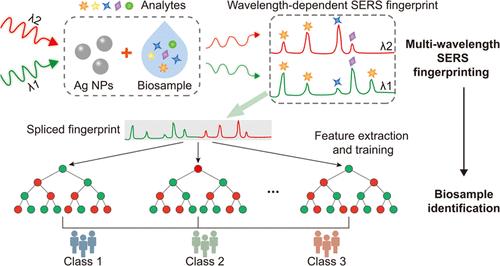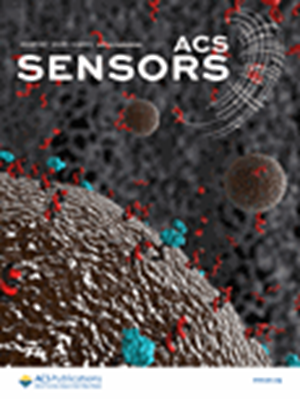Multiwavelength Surface-Enhanced Raman Scattering Fingerprints of Human Urine for Cancer Diagnosis
IF 8.2
1区 化学
Q1 CHEMISTRY, ANALYTICAL
引用次数: 0
Abstract
Label-free surface-enhanced Raman spectroscopy (SERS) is capable of capturing rich compositional information from complex biosamples by providing vibrational spectra that are crucial for biosample identification. However, increasing complexity and subtle variations in biological media can diminish the discrimination accuracy of traditional SERS excited by a single laser wavelength. Herein, we introduce a multiwavelength SERS approach combined with machine learning (ML)-based classification to improve the discrimination accuracy of human urine specimens for bladder cancer (BCa) diagnosis. This strategy leverages the excitation-wavelength-dependent SERS spectral profiles of complex matrices, which are mainly attributed to wavelength-related vibrational changes in individual analytes and differences in the variation ratios of SERS intensity across different wavelengths among various analytes. By capturing SERS fingerprints under multiple excitation wavelengths, we can acquire more comprehensive and unique chemical information on complex samples. Further experimental examinations with clinical urine specimens, supported by ML algorithms, demonstrate the effectiveness of this multiwavelength strategy and improve the diagnostic accuracy of BCa and staging of its invasion with SERS spectra from increasing numbers of wavelengths. The multiwavelength SERS holds promise as a convenient, cost-effective, and broadly applicable technique for the precise identification of complex matrices and diagnosis of diseases based on body fluids.

用于癌症诊断的人体尿液多波长表面增强拉曼散射指纹图谱
无标记表面增强拉曼光谱(SERS)能够从复杂的生物样品中捕捉到丰富的成分信息,提供对生物样品鉴定至关重要的振动光谱。然而,生物介质日益复杂和微妙的变化会降低由单一激光波长激发的传统 SERS 的鉴别精度。在这里,我们介绍了一种多波长 SERS 方法,该方法与基于机器学习 (ML) 的分类相结合,提高了用于膀胱癌 (BCa) 诊断的人体尿液标本的鉴别准确性。这种策略利用了复杂基质的激发波长依赖性 SERS 光谱轮廓,这主要归因于单个分析物中与波长相关的振动变化,以及不同分析物在不同波长上的 SERS 强度变化比的差异。通过捕捉多个激发波长下的 SERS 指纹,我们可以获得复杂样品更全面、更独特的化学信息。在多波长算法的支持下,我们对临床尿液标本进行了进一步的实验研究,证明了这种多波长策略的有效性,并利用越来越多波长的 SERS 光谱提高了 BCa 诊断的准确性并对其入侵进行了分期。多波长 SERS 是一种方便、经济、广泛适用的技术,有望用于复杂基质的精确鉴定和基于体液的疾病诊断。
本文章由计算机程序翻译,如有差异,请以英文原文为准。
求助全文
约1分钟内获得全文
求助全文
来源期刊

ACS Sensors
Chemical Engineering-Bioengineering
CiteScore
14.50
自引率
3.40%
发文量
372
期刊介绍:
ACS Sensors is a peer-reviewed research journal that focuses on the dissemination of new and original knowledge in the field of sensor science, particularly those that selectively sense chemical or biological species or processes. The journal covers a broad range of topics, including but not limited to biosensors, chemical sensors, gas sensors, intracellular sensors, single molecule sensors, cell chips, and microfluidic devices. It aims to publish articles that address conceptual advances in sensing technology applicable to various types of analytes or application papers that report on the use of existing sensing concepts in new ways or for new analytes.
 求助内容:
求助内容: 应助结果提醒方式:
应助结果提醒方式:


